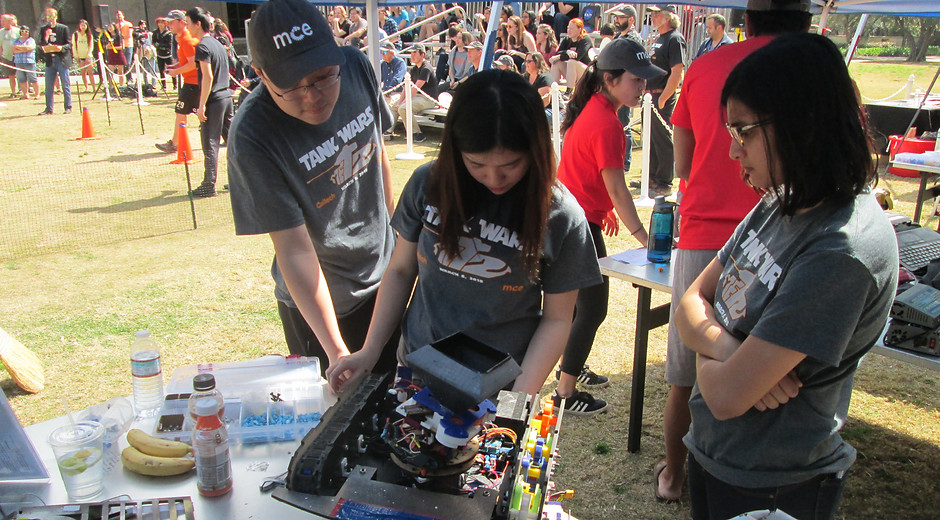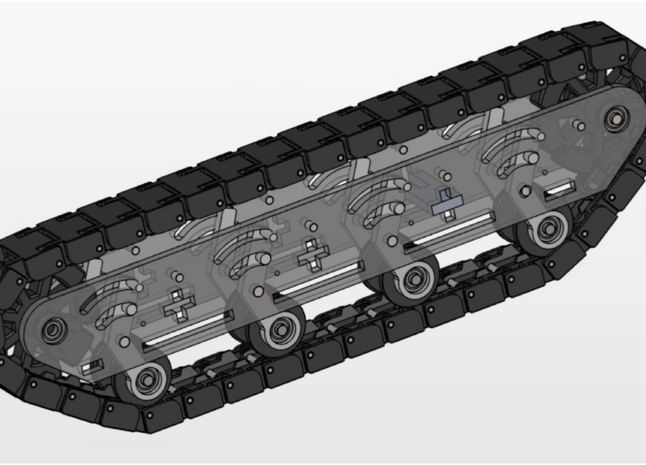
ROBOTICS: TANK WARS
During a span of 20 weeks and with a team of 4, I designed, assembled, and programmed three 15" x 15" robot tanks from scratch to completion. These tanks are controlled by Arduinos in tele-operated and autonomous modes and work together in a class competition to take and guard positions on a grass field while simultaneously shooting other robots. We worked with a budget of $1300 and presented our ideas during preliminary design reviews and critical design reviews.

During our 20 week design process, we went through many iterations and even attempted a few different designs for our robots. In the below gallery, you can find the main iterations and some notable parts design.
A CLOSER LOOK AT OUR DESIGN...
Transmission:
Our transmission consist of two stages of plastic spur gear transmissions with an overall gear ratio of 6.7. The walls of the transmission box were waterjetted from ABS and were screwed to a 3D printed PLA cap that secured the walls in place. The transmission was also designed to be symmetric for ease of assembly.
Shooter:
Our gun has two degrees of motion: a servo motor raises and lowers the platform allowing us to point the gun up and down and a stepper motor gives our turret the ability to turn 360 degree. This allowed us to aim while driving our tank in a different direction.
The flywheels in the gun are powered by two AC motors and another servo motor loads the nerf balls by pushing it into the flywheels.
Suspension/ Treads:
Extension springs connect the tip of the legs in our treads to a fixed point on the wall. Whenever the tank drives over uneven ground, the extension springs will allow the leg to bend, giving our tank suspension. Our treads and sprockets are also self-designed and 3D printed.

MY ROLE IN THE TEAM:
In terms of specific tasks, I was fully in charge of the transmission, worked on other specific parts of the CAD (i.e. armour and motor mounts), and helped with wiring. I also performed a significant portion of the machining and assembling and did a great deal of testing and trouble shooting. Additionally, I was fully in charge of purchasing, budgeting, and sourcing components.
Within the team, I functioned as the team leader, making sure tasks were organized and deadlines were met. I led meetings and make sure that everyone is on the same page. I tried to made sure that everyone made an input and that when they do, their voices were heard. Whenever there was conflict and tension between team members, I talked to both sides and helped resolve them.

WHAT WORKED AND WHAT DIDN'T WORK
Fall Term
What worked:
-
Our design for bearing blocks on the shaft mounts cleverly secured the bearings.
-
The big squishy wheels we picked were good for going over obstacles.
-
Worm gears worked especially well on the seesaws and gave us a lot more control over the vehicle.
What went wrong:
-
The wheels we picked also had too much friction and were giving us trouble to turn on grass.
-
Our dell rings did not have enough strength to hold the worm wheel in place.
-
Our worm wheels kept on getting eaten up by the worm gears because with the budget constraint, we had to order brass worm wheels with steel worm gears.
Winter Term
What worked:
-
Our guns were really effective in contributing to the action of the game and to eliminate other robots when they tried to take bases from us or blocking us from taking bases.
-
Our tanks were also very maneuverable and powerful. They were able to climb the ramp and seesaw at ease and drive quickly over the obstacles.
What went wrong:
-
One of our gears became misaligned
-
Our sprockets kept slipping- which became a huge problem that restricted our movements. This was mainly due to the heat inserts shearing the plastic, detaching from the plastic making the sprockets loose from the shafts.
-
Our power gain was not enough and lost more and more power as our system wears out towards the end of the competition. This could be fixed by more software modification, but we did not want to risk driving an unfamiliar power gain and did not have time to re-tone the motor controls during the competition.

ABOUT THE TOURNAMENT
The field layout for the competition is shown on the left. The yellow dots are "bases" that the robots can take over by pushing a button. However, another robot can take over the base at anytime by pressing the button from the other side. Thus, the robots not only have to take over bases, they also have to guard it. On top of that, the robots are allowed to have shooting mechanisms on top of them to shoot the other robots down.
The competition will be held on grass, and at the start of every match, there will be a period of autonomy during which the teams are not allowed to directly control their robots. The final competition only had one seesaw base.















